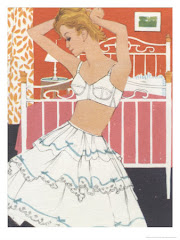Examples of Historical Draped
1. The 1880s Bustle Dress
 Rococo and Mediaval era influence the Bustle dress in 1870s-1880s, but the embellishment of a fullness skirt is moved to the back. This Bustle dress is designed and reproduced by a fashion design student, who would like to make a Bustle dress in modern fabrics. The bodice, dress and hat are made from satin which is trimmed in hand tartan.
Rococo and Mediaval era influence the Bustle dress in 1870s-1880s, but the embellishment of a fullness skirt is moved to the back. This Bustle dress is designed and reproduced by a fashion design student, who would like to make a Bustle dress in modern fabrics. The bodice, dress and hat are made from satin which is trimmed in hand tartan.2. Thai Traditional Dress
 In the past, women draped a long rectangle for a top, which is called Sbai, and for a bottom, which is called Phasin, and fasten with any ornamental belt. Textiles of Sbai and Phasin could imply a society class of wearer. For instance, royal family members or elites would wear any ornamental fabric and fasten with golden belt. In contrast, a lower class would wear plain fabric.
In the past, women draped a long rectangle for a top, which is called Sbai, and for a bottom, which is called Phasin, and fasten with any ornamental belt. Textiles of Sbai and Phasin could imply a society class of wearer. For instance, royal family members or elites would wear any ornamental fabric and fasten with golden belt. In contrast, a lower class would wear plain fabric.3. 21th Century Era

The Spring-Summer collection of Lanvin shows a modern drapery style by using difficult techniques of handling in order to drape and pleat polyester, make spiral ruffles, and invent a puffy form of a quilted coat. Additionally, the designer decorate polyester fabric with gold sequins and jewelry to make his dresses, and layer one dress on another one in order to make a whole dress.
Examples of Tailored Garments
1. The Edwardian
 In this era, the silhouette of a bodice is an exaggerate bigger proportion of sleeves, which is called the leg of mutton sleeves style. It is due to shape of sleeves are similar to a leg of mutton, which a top part is bigger than a bottom one. Usually, women wore the bodice with a flared skirt.
In this era, the silhouette of a bodice is an exaggerate bigger proportion of sleeves, which is called the leg of mutton sleeves style. It is due to shape of sleeves are similar to a leg of mutton, which a top part is bigger than a bottom one. Usually, women wore the bodice with a flared skirt.2. Korean Traditional Dress
 A Korean traditional dress is called Jeogori, which is a little blouse that is worn upper the big flared skirt. The length of Jeogori depends on any situation of the country, Korea. For instance, the economy is recessive during a war, people had to use less fabric, so the length of Jeogori was influenced to be shortened.
A Korean traditional dress is called Jeogori, which is a little blouse that is worn upper the big flared skirt. The length of Jeogori depends on any situation of the country, Korea. For instance, the economy is recessive during a war, people had to use less fabric, so the length of Jeogori was influenced to be shortened.3. 21th Century Era
 In this era, fashion trends tend to be minimalism style, which is less ornamentation and in neutral colors. This picture is Spring-Summer Collection 2009 of Chloe', which the sleeves of a blouse is inspired by Edwardian style, but decreases some embellishments.
In this era, fashion trends tend to be minimalism style, which is less ornamentation and in neutral colors. This picture is Spring-Summer Collection 2009 of Chloe', which the sleeves of a blouse is inspired by Edwardian style, but decreases some embellishments.

No comments:
Post a Comment